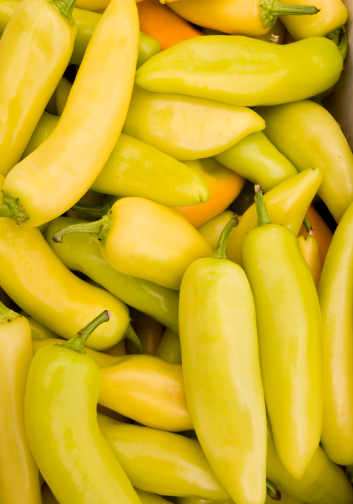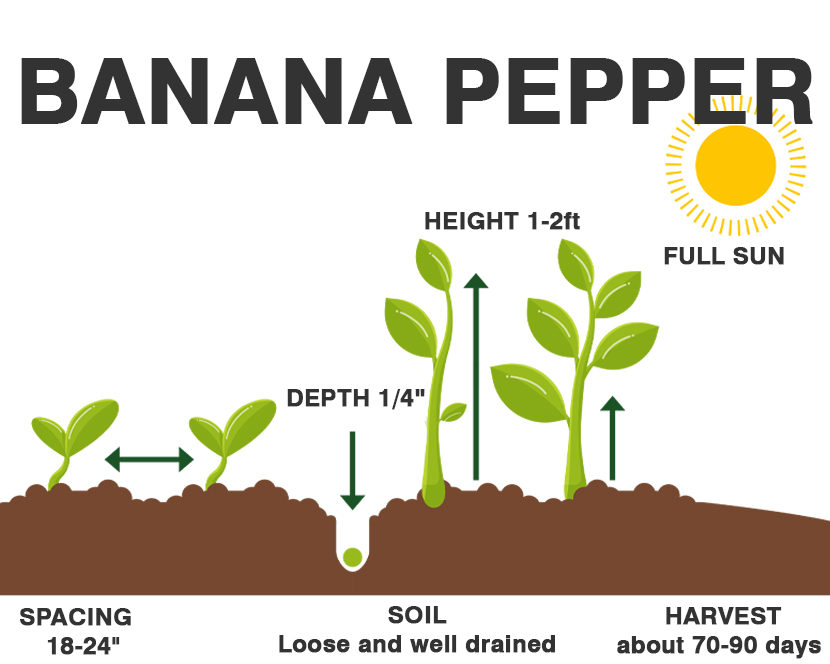The banana pepper is a mild, medium-sized chili pepper with a tangy, slightly sweet taste. It is not considered a hot pepper, offering either no heat or a slight tingle. Compared to the mildest jalapeno pepper, it is 5 times milder, if offering any heat at all.
Also known as the yellow wax pepper or banana chili, the Banana Pepper has a mild, sweet taste that is very popular on many types of foods. It is commonly eaten on pizza, in Greek salads, on sandwiches, or stuffed with meat and/or cheese.
They also add a bit of sweetness to salsa and an interesting flavor, while other peppers add the heat.
They may be pickled or used fresh. Pickled banana peppers are very popular, often confused for pepperoncini peppers. As the name suggests, it is typically a bright yellow or yellow-green, but they may mature to orange or red if left to ripen

| Common Name | Banana pepper |
| Botanical Name | Capsicum annuum |
| Family | Solanaceae |
| Plant Type | Perennial, vegetable |
| Size | 1–4 ft. tall, 1–2 ft. wide |
| Sun Exposure | Full sun |
| Soil Type | Moist, well-drained |
| Soil pH | Acidic, neutral |
| Bloom Time | Summer |
| Hardiness Zones | 9–11 (USDA) |

When to Plant?
This will be determined by your planting zone. There is a final frost date for each area. As a result, you can plan your gardening activities around this date. Check our Frost Dates Across North America: First & Last Frost Dates Chart. However, the date will not be the same for every plant.
How to Plant
Banana pepper plants are best started indoors, six to eight weeks or more before the last frost date for your area. Slow starters, germination takes 2 – 3 three weeks. Seedlings grow slowly at first.
Sow seeds 1/4″ deep, and cover with light, seed starting soil.

Tip: We strongly recommend use of a heated germination mat, to reduce germination time, and increase germination rate.
Transplant seedlings after the last frost date in your area. If the weather is still cool, delay transplanting a few days, to avoid stunting the plants. Keep the plants in a cold frame, indoors or next to the house.
How to Cultivate
Grow Sweet Banana Pepper plants in full sun, and in a rich, well draining garden soil. Prior to transplanting outdoors, adding plenty of compost, manure, and a general purpose fertilizer.
The plants like the weather hot. Space 18-24 inches apart, in rows 24 to 36 inches apart.
Banana Pepper plants prefer moist soil. Add plenty of water during hot, dry summer months.
Mulch around the pepper plants to keep down weeds, and to retain soil moisture.
As the peppers develop, switch over to a fertilizer higher in Phosphorous and Potassium. A high nitrogen fertilizer can result in a great looking bushy, green plant, with few fruit.
Peppers are self pollinating. They can cross pollinate with pollen carried by bees or other insects. If you are going to save the seeds for next year, do not plant different varieties near each other.
How to Harvest
The best time to harvest banana peppers is when they are full sized and have firm skins. You can take them off the plant when they are yellow or wait until they mature to a deep orange or even red.
Growing banana peppers begin to slow their production when temperatures at night cool. Cut off individual fruits as you need them. When the season comes to an end, pull the entire plant and hang it to dry. Keep fresh fruits in the crisper or a cool, dark location for up to a week.
Hydroponics
Germination: Begin by germinating the Banana pepper seeds in a small tray or pot filled with seed starting mix. Keep the soil moist and warm (around 70°F) until the seedlings emerge, which usually takes about 5-10 days.
pH range: Maintain the pH level of the nutrient solution between 5.5 and 6.5. This range ensures that the plant can absorb nutrients effectively.
EC: The ideal EC level for Banana pepper is around 1.5-2.5 mS/cm. This level provides enough nutrients for the plant to grow healthily.
PPM: The recommended PPM (parts per million) for Banana pepper is around 1400-1800 ppm. This level will provide sufficient nutrients for the plant to thrive.
Humidity: Banana pepper requires moderate to high humidity levels. Maintain the humidity level around 60-80% to prevent the plant from drying out.
Light hours: This plant requires at least 12-14 hours of light each day. This can be achieved by using grow lights or by placing the plants near a sunny window.
Temperature air: Banana pepper grows best in temperatures between 70°F to 80°F during the day and 60°F to 70°F at night. Maintaining these temperature ranges will ensure optimal growth.
Temperature water: The nutrient solution should be maintained at a temperature between 65°F to 75°F. This temperature range ensures that the roots of the plant can absorb nutrients effectively.
Overall, growing Banana pepper hydroponically can be a rewarding experience, and following these guidelines can help you grow healthy and vibrant plants.



